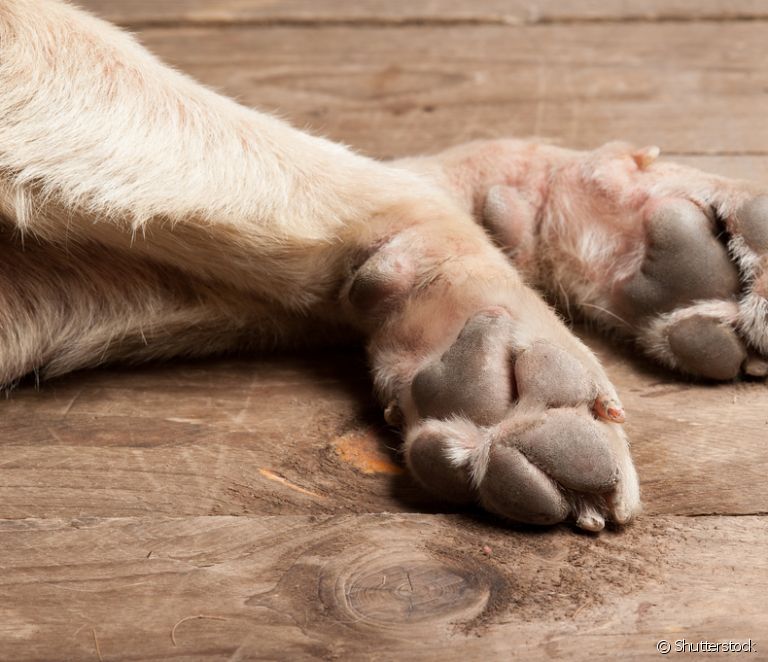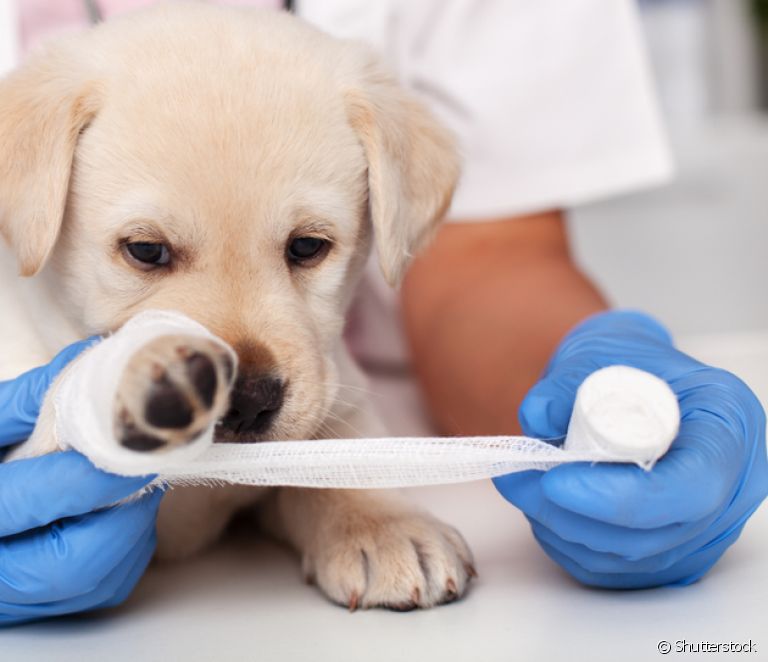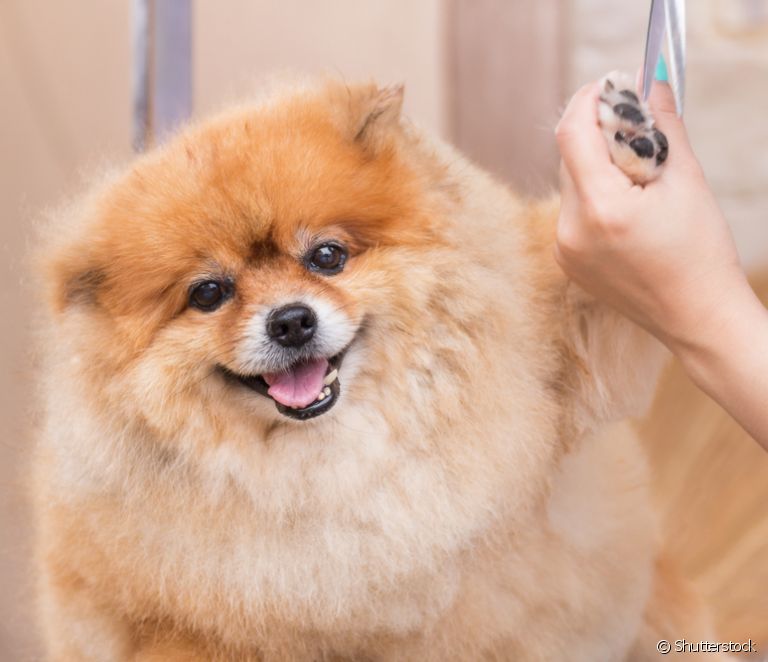Dog's paw: anatomy, care and curiosities... learn all about this part of your friend's body

Table of contents
A dog's health depends on a lot of care for the animal's body - including its paws! They are the ones that provide all the necessary support so that the dog can run, play and jump, just the way they like it. Many owners do not pay enough attention to the dog's paw, and this can end up triggering a series of problems in the region, which bring a lot of discomfort to the animal.We've gathered here everything you need to know about this part of the dogs' body: from care and diseases that can affect the place, to curiosities and basic tricks (how to teach the dog to give the paw, for example). Check it out!
Understand the anatomy of the dog paw
- Nails: the dog's nail acts as a kind of "claw" for the animal, as it can also use this area of the body as a defense and/or attack mechanism. It is an area that needs to be very well cared for and should be cut regularly to prevent the animal from accidentally injuring itself or other people.
- Digital cushions: this part corresponds to the "toes" of dogs, the softest part being located at the ends of the paw. The pads help to reduce impact and act as a kind of shock absorber.
- Metacarpal cushion: This is the region that corresponds to the palm of the hand. Due to the large amount of fat present, the dog can step on cold ground without any problem, but it is necessary to be aware of soils with a very hot temperature, as this can end up causing discomfort to the animal.
- Carpal cushions: these pads are located on the dog's front paws, acting as a kind of "brake" and preventing the pet from slipping.
- Erected: Also known as the dog's "fifth finger", the ergot is considered an internal finger that has a similar function to the human thumb. That is, it is with it that the dog can hold food and other objects.
Paw: dogs need special care for this part of the body
The dog's paw is naturally more resistant, since the pads are rougher and thicker. Even so, it is extremely important to take great care of this region of the animal's body to avoid problems and diseases. Therefore, the guardian must always pay attention to issues such as hygiene and grooming of the hair that is close to the pads.
The hair needs to be cut in this area to avoid the emergence of parasites (such as ticks) and bacteria, which can trigger problems in your friend's paw. In addition, the long coat in this area can make the paws more slippery.
Another very important precaution is not to take your dog for a walk when the sun is very strong, as the high temperature of the asphalt can end up burning and hurting the dog's paw. Always prefer the early morning, between 6am and 10am, or late afternoon (after 4pm), when the sun is less aggressive. After the walk, always wipe the paws with a clean, damp cloth or wipeswet wipes suitable for pets.
Dog nails: how to clean the area?
Just like humans, your dog also needs to cut its nails and can suffer from ingrown toenails. In addition, if they get too long they can end up hurting the animal or scratching other people unintentionally. The size of the dog's nail is also a factor that influences the way the animal walks, as they can end up hindering it.
But after all, how do you know how much nail needs to be cut? In dogs that have a lighter nail, the ideal is to cut only the most transparent area of the nail. In dogs with black nails, the tutor should cut little by little until the curvature is reached. But it is worth remembering that under no circumstances should the corncob be cut, huh? This can bring a lot of pain to the animal and bleeding. To make theIf you are unsure, it is best to take your dog to a vet or pet shop to have someone with experience do the procedure.




Bruised dog paw: what to do?
Some of the most common problems that can affect your friend's paws are contusions, dislocations and even fractures. A contusion can occur, for example, when the dog accidentally hits his paw somewhere and the muscle ends up swelling and forming a hematoma. It is a situation that usually improves after a while, without the need for interventions. However, if the pet demonstrates to beIf your pet is in a lot of pain, taking it to the vet is the best solution, so the doctor can check if any measures should be taken.
The luxation, in turn, directly affects the joint of the dog's paws, causing the bone to shift. It is often a very noticeable situation that causes a lot of pain in the animal, and it is essential to take the pet to the veterinarian to seek the best treatment. In some cases, surgery may be necessary.
When the dog's paw suffers some kind of fracture, surgery is almost always the best alternative. This is because, as the bone has been broken, the surgical procedure is usually much more effective than the use of splints, for example. But remember: always seek the opinion of an expert on the subject to know what is the necessary attitude to take care of your friend.
Dog paw: see other problems that can affect the area
- Allergies: contact with certain substances, such as pollen, can trigger an allergic crisis on the animal's skin. So always keep an eye on your friend's surroundings so that he does not run the risk of having an allergy.
- Burns: burns are more common than you might think, and they are usually caused by contact with very hot ground. To avoid them, it is best to walk your dog at times when the sun is not so strong.
See_also: Dermatophytosis in cats: understand more about this zoonosis that is quite contagious- Dryness of the skin: With the drop in temperature, your dog's paw can become dry, as can your skin in general. There are specific moisturising creams for dogs that can help with this. Talk to a vet.
- Parasites: usually, the appearance of parasites in the paw area is linked to the hair that is around the pads - so they should be cut regularly. Fleas, ticks and mites are the most common parasites. If the guardian notices the presence of any of them on the animal's body, it is essential to take measures to end the problem - such as the use of tick and flea remedies.
- Psychological problems: Stressful situations or excessive anxiety can cause the dog to create the habit of biting or licking its own paw as a form of "relief". This can end up causing injuries in the area. Always be aware of your pet's behavior to prevent this from happening!
See_also: All about catnip: what it is, how it works and catnip benefits6 curiosities about dog paw that you probably didn't know
1) You can tell the size of a puppy by its paw. To find out, just look at the area. If it is disproportionate and larger than the rest of its body, it means that it will still grow a lot. If the puppy's paw is smaller, it will be small.
2) Dogs have about 319 bones in total, but most of them are exclusively part of the animal's paws. Who knew that such a tiny region has so many bones, right?
3) After a walk, try giving your dog a paw massage. This helps your pet relax and relieve tension - and may even make them calmer. Don't insist if they don't like the cuddle, ok?!
4) The ergots, called the "fifth finger" of dogs, are very useful when the animal wants to "grab" an object - either to play or to eat. They do not make much difference when it comes to cushioning or absorbing impacts, like the pads.
5) The bones of the dog's paw are fundamental to its support, as the animal tends to lean mainly on its toes rather than its heel.
6) The unpleasant smell that usually accompanies the dog's paw is caused by bacteria and fungi in the area, but they do not harm the animal.

